Design Patterns & Decisions
This page will be updated regularly in the iterative development of VIBSO to document modeling decisions and design patterns.
Following best practices in ontology development, we will reuse established design patterns whenever possible.
Since most ontologies we reuse are OBO Foundry based, we also reuse their design patterns to be logically sound and
interoperable. This entails committing to its underlying ontological framework, which is on the most abstract level
grounded in the Basic Formal Ontology (BFO) 2.0 classes only version and the current version of the Relation Ontology
(RO).
These patterns are expressed formally in the logical definitions of the imported classes in form of asserted
rdfs:equivalentTo or rdfs:subclassOf axioms and in the logical definitions of the imported properties in form of
asserted rdfs:domain and rdfs:range axioms and their type (e.g. transitive, functional, symmetric, etc.).
Although less formally binding, the textual definitions of the classes and relations constituting these pattern are
also part of their expression.
VIBSO TBox
Here you can see VIBSO's current terminology box (TBox) that focuses on vibrational Raman spectroscopy and which also shows how VIBSO depends on reusing existing ontology classes, relations and design patterns.
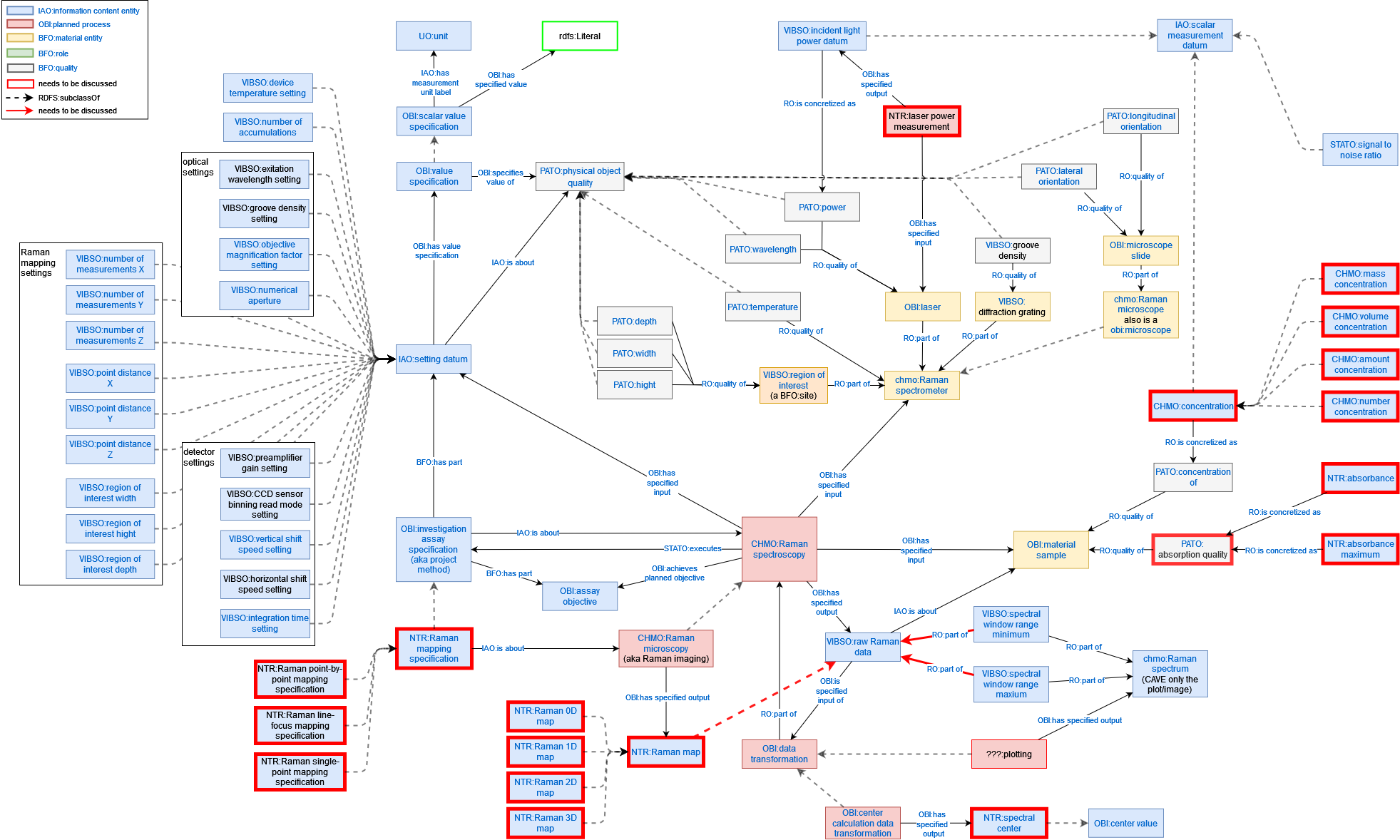
This TBox is supposed to be updated iteratively whenever a new term is being discussed for inclusion. We hope that it might be easier for domain experts to define technical terms in this ontological framework by adding them here first.
A higher resolution HTML version of this TBox and the below discussed pattern graphs with links to the used terms in the NFDI4Chem Terminology Service can be found here. The source file to edit these with the draw.io app is here.
Planned Process Pattern
Within the above TBox we can find specializations of a central class defined in the Ontology for Biomedical Investigations (OBI) which is called 'planned proces'. This class is central in the OBO framework because it provides a general pattern for defining all kinds of processes in which some agent(s) act(s) according to a set of predetermined instructions in order to achieve a certain outcome. Logically, it is defined as a "process that realizes a plan which is the concretization of a plan specification". Following the formalization of this definition, we can safely ignore the very abstract 'plan' class and only need to focus on the 'plan specification' that gets concretized by a 'plan'. A 'plan specification' is defined in the Information Artifact Ontology (IAO) as the directive information that specifies through its parts which actions have to be performed ('action specification') in order to achieve the intended goals ('objective specification') of a 'planned process'. It thus resembles more fittingly what we usually mean in natural language when speaking of a plan or method. To have a direct relation from a 'plan specification' to its 'planned proces', we can reuse 'executes' from the Statistical Methods Ontology (STATO), as it is defined exactly for this purpose.
The pattern can be visualized like this:
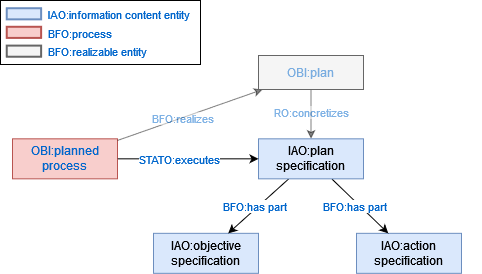
We could apply this very general pattern for example to describe the baking of cookies like this:
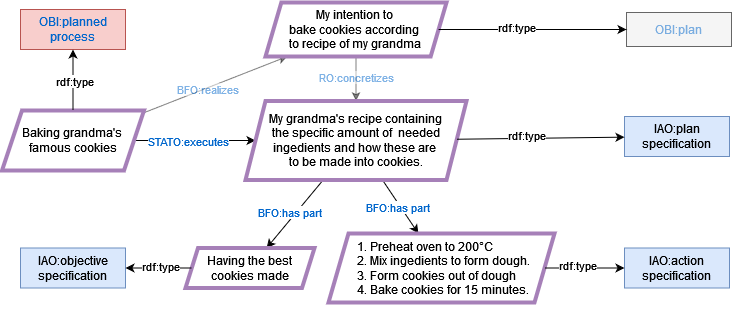
OBI Core Assay Pattern
As defining all relevant types of vibrational spectroscopy assays, including their different kinds of data outputs and their experimental setups from a research data management perspective is the central goal of VIBSO, we are always dealing with special kinds of planned processes. For this we can leverage the fact that there also already exists an 'assay' class within OBI, which we can reuse as the central parent class for all vibrational spectroscopy assays. It is defined as:
A planned process that has the objective to produce information
about a material entity (the evaluant) by examining it.
This definition, along with the logical axioms asserted on this class and their entailments, constitute a core design pattern which can be represented graphically like this:

To exemplify this pattern within the domain of VIBSO we can instantiate these classes like this.
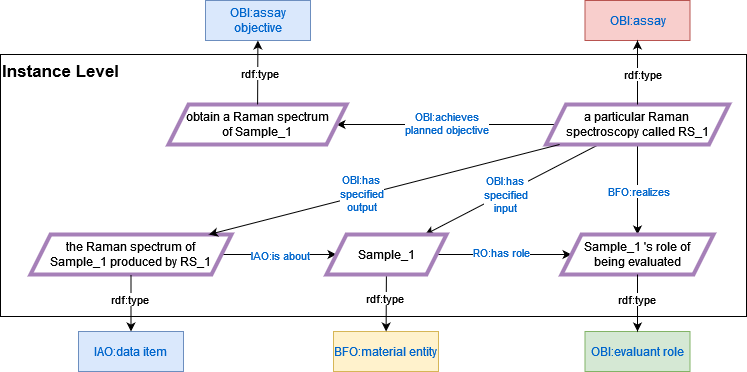
To better understand the defined logic of this pattern, it seems useful to look at its parts more closely.
Subjects of an Assay
As we can see in this graph, the use of the term 'assay' is restricted to only those planned processes that examine a 'material entity' via the 'has specified input' relation. A material entity is defined in BFO as anything that is extended in three-dimensional space, has a unique identity and contains some portion of matter. This could include objects identified by their mass, material boundaries, or energy. Therefore, a rock, a nostril, or an elementary particle such as an electron or quark, all qualify as a material entity. This restriction on the meaning of assay is not just given in the above definition, but also in the definitions of 'assay objective' and 'evaluant role'. Therefore, a planned process which examines a thing that is not a material entity cannot be classified as an assay in this sense, its role can never be an 'evaluant role' and its objective can never be an 'assay objective'.
Outputs of an Assay
When looking at the output of an 'assay', we see that, although its textual definition only speaks of information in general, the axiomatization in this pattern rather restricts the possible output to 'data item', a special kind of information, via the 'has specified output' relation. The 'data item' class is defined in IAO as a kind of information "that is intended to be a truthful statement about something [...] and is constructed/acquired by a method which reliably tends to produce (approximately) truthful statements." Although this definition might suggest otherwise, an editor note on this class and the synonym 'data' make clear that 'data item' also includes the kinds of information that are compositions of multiple truthful statements about a thing. In the context of the 'assay' pattern, we can thus say that an 'assay' must produce a truthful statement or a composition of truthful statements about the examined 'material entity'. To apply this to an example from VIBSO's domain, we can say that a Raman spectrum is a 'data item' because it is composed of the measurements (e.g. scattered light intensity values) that were recorded during a Raman spectroscopy assay.
Defining an Assay According to the OBI Core Assay Pattern
There is an axiom asserted on the assay class which states that whenever an 'assay objective' is achieved by the use of a planned process, this process must be classified as an 'assay'. Hence, the 'assay objective' must be the information that describes the assay type by specifying what kind of data about the evaluated material is to be produced. Accordingly, the definition of 'assay objective' reads: "an objective specification to determine a specified type of information about an evaluated entity (the material entity bearing evaluant role)". However, 'analyte measurement objective' seems to be the only subclass of 'assay objective' in OBO ontologies, and it is only used to group roughly 600 kinds of assays as an 'analyte assay', which produces information about the presence, concentration, or amount of a molecular entity or an atom, within the evaluated material. These analyte assays themselves are formally stratified mostly by specifying which kind of molecular entity or atom is being analysed within the evaluated material. The remaining 1000+ specializations of assay in OBI are formally stratified either by focusing on the evaluated material, a certain characteristic of the evaluated material, the specific kind of data output, the devices used, or a combination of these.
This shows that we can use various axis of differentiation within the core assay pattern to classify a specific kind of assay. Using logical axioms in the formal definition of assay types helps alot, as it allows multiple inheritance to be inferred automatically by reasoners, an example of which is '3D molecular structure determination assay of an antigen:antibody complex'. What some assay definitions in OBI also indicate is that we sometimes need to extend the core OBI assay pattern to classify certain assay types. Especially, if we want to differentiate or group assays in more detail, like when we need more information about the used method including the devices and device settings.
Extending the OBI Core Assay Pattern
Since 'assay' is a specialization of 'planned process', we know that its method (plan) must be defined in some kind of 'plan specification'. In OBI, we find the class 'investigation assay specification', which is defined as a 'plan specification' that indicates the assay type, and which is also called 'Project Method'. Some provided examples for this class are: sequence or mass spectrometry. Hence, we should be using this subclass of 'plan specification' in our assay pattern, and we can assert that an essential part of it is an 'assay objective'. Similarly, we can say that the information which determines the experimental setup of a specific assay, such as the needed devices, their settings or the way in which the evaluated sample must be prepared, is also an essential part of the 'investigation assay specification'.
Assay Devices
To represent the instruments used in an assay, we can import the already existing 'device' class from OBI and link it to 'assay' via the 'has specified input' relation. The definition of this relation makes clear that the range of it, in our case a 'device', must be specified in a 'plan specification', in our case an 'investigation assay specification'.
Assay Device Settings
To represent the part of an 'investigation assay specification' that is the information which specifies what kind of configurable qualities an assay device must have, we can use the class 'setting datum', since it is defined as a 'data item' about "some configuration of an instrument". To represent the configurable device quality specified by a setting datum, we can use the class 'physical object quality' from the Phenotype and Trait Ontology (PATO), as it is the parent class of more specific physical qualities, such as temperature, wavelength, mass or position. This quality can be related to the device via the 'quality of' relation from BFO. Since the actual quantitative value of the 'physical object quality' specified by a 'setting datum' can be encoded using different units of measurement, we also need a way to formally represent this. The way this is currently done in OBI is via the 'value specification' class, which is defined as an information "that specifies a value within a classification scheme or on a quantitative scale". We can link this class to a 'setting datum' via the 'has value specification' relation which is a specialization of the very general 'has part' relation. For the part of this value encoding that represents a given measurement unit, such as any SI unit, we can use one of the instances of the class 'unit' defined in the Unit Ontology (UO), and link it via the 'has measurement unit label' relation from IAO. The last missing pieces are the links between a value specification and the actual literal value respectively the configurable device quality. Both are defined in OBI as 'has specified value', respectively 'specifies value of'.
Having described all the classes and relations we need to extend the OBI core assay pattern, we can now visualize
this in from of the following graph:
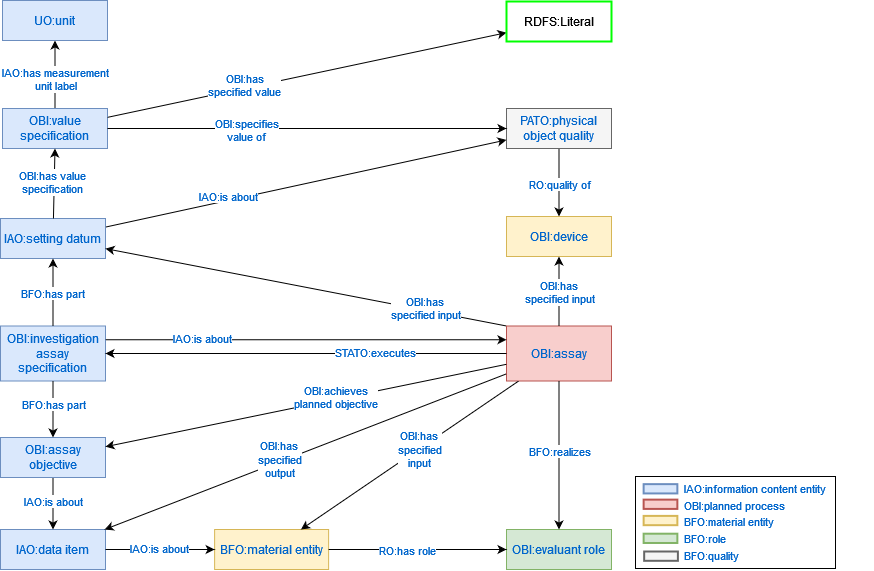
When comparing this graph to the previous one, one can see that we have also added an 'is about' relation between 'assay objective' and 'data item'. This relation was not added to the core pattern previously, as it is not formally asserted in OBI, but only given in the textual definition of the 'assay objective'.
To exemplify this extended pattern in the context of VIBSO, we can instantiate its classes as follows:
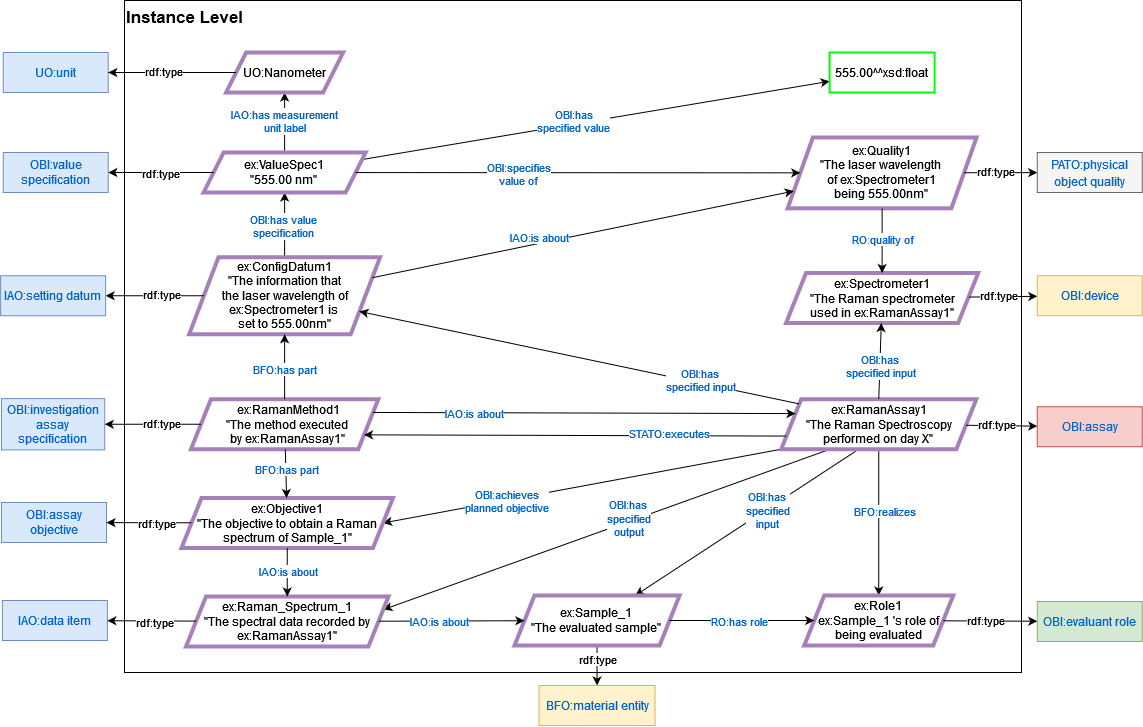
Defining an Assay According to the Extended Assay Pattern in the Context of VIBSO
As discussions with domain experts in the VIBSO development calls have made clear, the classification of the various types of Raman spectroscopy as currently done in CHMO has some problems (see issue#103). All of these types have in common that they somehow record the Raman scattering of the evaluated sample. However, their methodology differs in the ways in which the Raman scattering is produced, recorded or subsequently processed, by using either different devices, device settings, sample preparation steps or signal recording steps. We thus need the extended assay pattern described here, to be able to describe these different methods in more detail and thereby formally define the various types of Raman spectroscopy assays they specify.
The Assay Pattern in a Bigger Picture
This assay pattern can of course combined with other planned process patterns, to be able to describe its embedding in a grander context. Without going into the details, the following TBox shows how this can be done with respect the competency questions:
- Who performed the assay?
- What kind of data transformations where performed on the data output of the assay?
- What kind of sampling process was done before the assay?
- What is the investigation the assay is a part of?
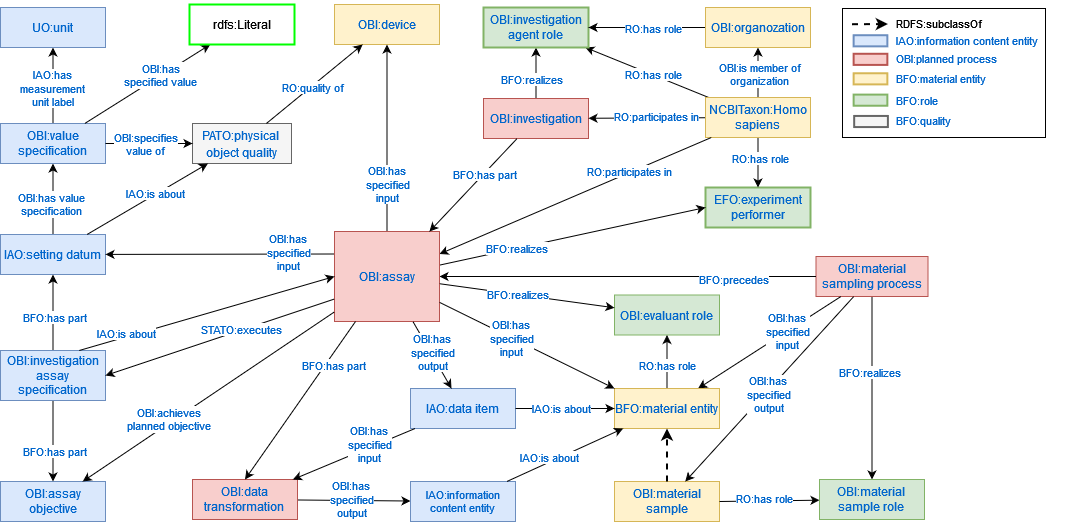
Using Example Instances in VIBSO
In the previous VIBSO development calls, it became apparent that the proper use of the design patterns described here should be illustrated with concrete example instances. This should not only make it easier for the domain experts with little knowledge on ontology development to follow. We also hope to be able to spot logical inconsistencies when minting new classes and asserting their class restrictions by using reasoners, such as ELK or HERMIT during the development.
We have thus added the ROBOT TSV template vibso_examples.tsv, to be able to add example instances for each class minted in VIBSO. Similar to the other ROBOT templates we use, this one gets automatically converted into an OWL component (vibso_examples.owl) that is being imported into the main editor file (vibso-edit.owl).
OBI Quality & Quantity Pattern
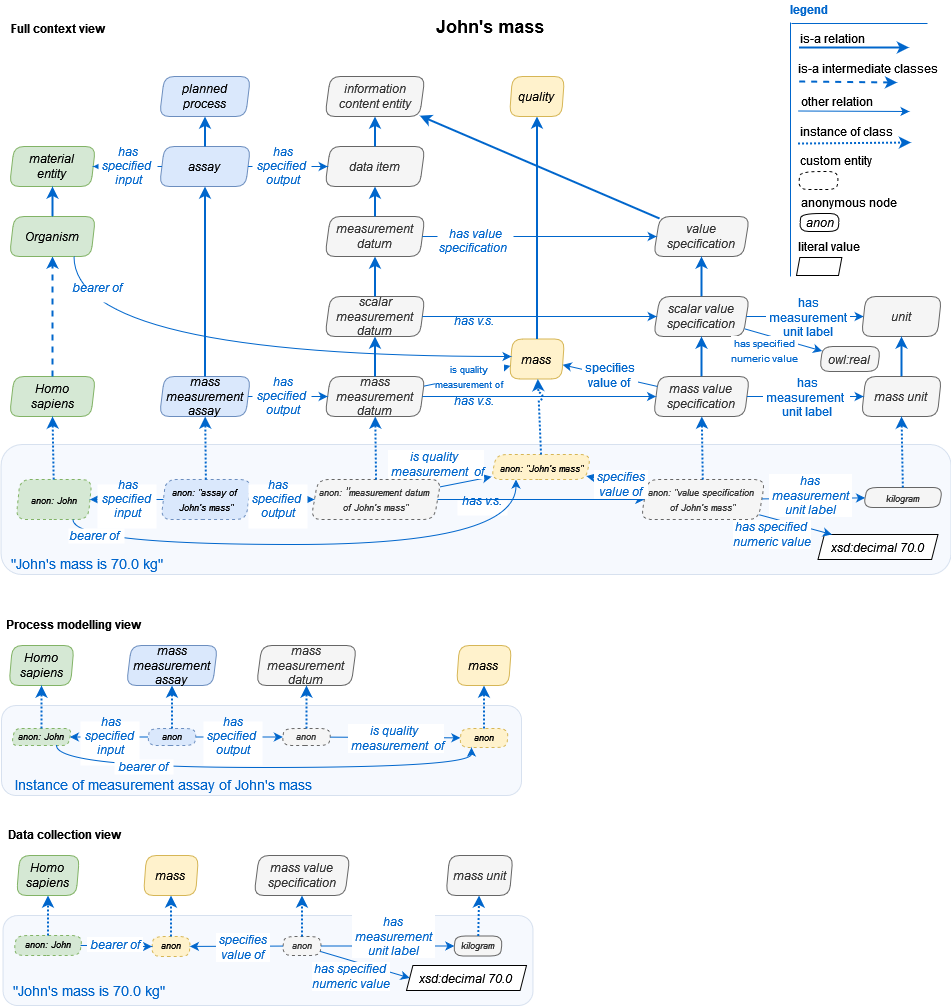 Since we are reusing OBO ontologies and their patterns, we also try to reuse OBI's way of modeling
data and values. Please read their documentation for more
background. Using this OBI pattern allows us to differentiate data values of qualities (aka attributes) of a material
entity, such as the spectroscope or sample, into data values that represent settings and those that represent
measurements. From a data repository use case perspective, we might not need this fine-grained approach and defining
qualities/attributes and their value specifications might suffice. Yet in order to allow the integration of VIBSO in
Electronic Lab Notebooks, such a differentiation will most likely be very useful. Although this pattern seems to
work in many OBO use cases, we need to see, if we have to adjust it for our needs. Other ontologies like QUDT or SIO
use slightly different patterns to model qualities and their quantitative representations.
Since we are reusing OBO ontologies and their patterns, we also try to reuse OBI's way of modeling
data and values. Please read their documentation for more
background. Using this OBI pattern allows us to differentiate data values of qualities (aka attributes) of a material
entity, such as the spectroscope or sample, into data values that represent settings and those that represent
measurements. From a data repository use case perspective, we might not need this fine-grained approach and defining
qualities/attributes and their value specifications might suffice. Yet in order to allow the integration of VIBSO in
Electronic Lab Notebooks, such a differentiation will most likely be very useful. Although this pattern seems to
work in many OBO use cases, we need to see, if we have to adjust it for our needs. Other ontologies like QUDT or SIO
use slightly different patterns to model qualities and their quantitative representations.
Measurement Example KG of the Assay Pattern
Lars Vogt and Tobias Kuhn demonstrate the use of the OBO assay pattern within a grander research context as follows
(cited from their preprint DOI:10.13140/RG.2.2.13742.59203, p.8):
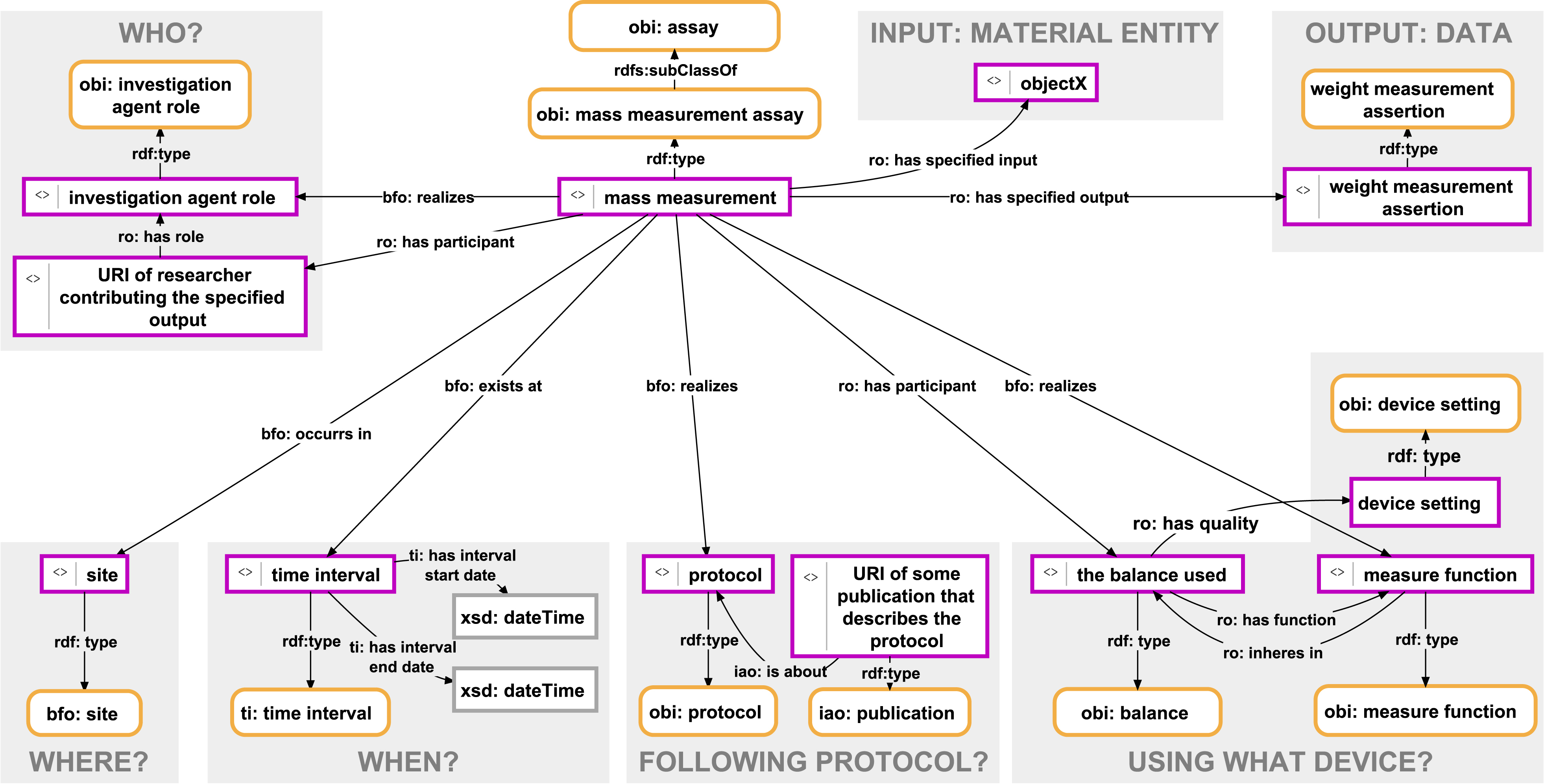
Figure 3: A detailed machine-actionable representation of the metadata relating to a weight measurement datum documented as an RDF ABox graph. The representation takes the form of an ABox semantic graph following the RDF syntax. The graph documents a mass measurement process using a balance. It relates an instance of mass measurement assay (OBI:0000445) with instances of various other classes from different ontologies, specifying who conducted the measurement, where and when it took place, following which protocol and using which device (i.e., balance). The graph furthermore specifies the particular material entity that served as subject and thus as input of the measurement process (i.e., ‘objectX’), and it specifies the data that is the output of the observation, which is contained in a particular weight measurement assertion.